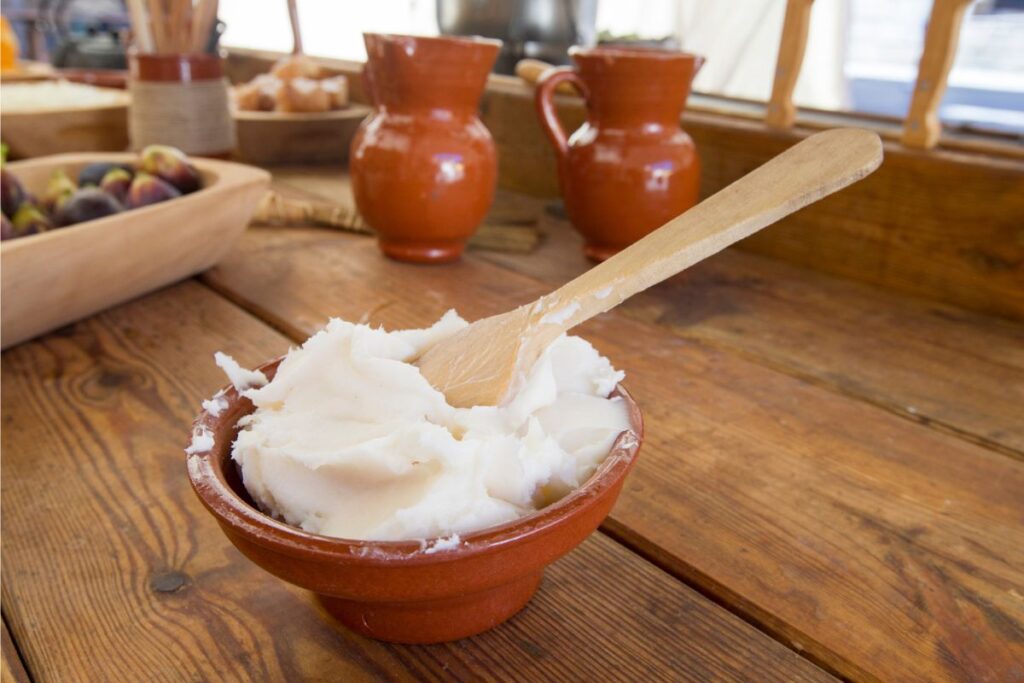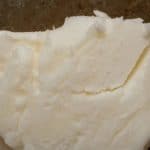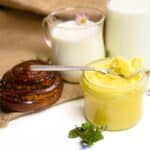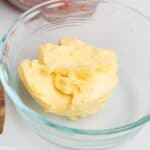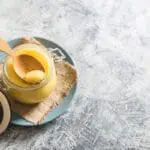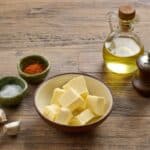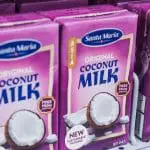Quick summary: Most common substitutes for lard are butter, vegetable shortening, olive oil, margarine, ghee, and coconut oil. But there are also some new ideas that you can use depending on the type of dish you are preparing
Lard has been around for centuries and is probably one of the reasons your grandma’s cooking tasted extra special. Before unhealthy hydrogenated fats came onto the scene, lard was one of the most popular fats used in baking and cooking.
Back then, the natural pork fat was rendered without any other chemical additions and could be stored at room temperature for many months. Even though there are many benefits to cooking with lard, it is not as readily available as it used to be.
Whether you are trying to reduce the calories in your cooking, need a vegan replacement, or can’t find any lard in store, there are a number of substitutes you can use instead. Most of them are also suitable for people needing to avoid lard for religious reasons.
In this guide, we’ll help you choose the best lard substitute to suit your needs and your recipe.
What is Lard?
Lard is cooking fat, very similar to butter in texture and consistency. It is, however, dairy free and is made from melted or rendered pork fat. It has a white color and is semi-soft at room temperature, hardens when refrigerated, and melts to a liquid when heated.
It is classified into different types according to how it is rendered. It can be odorless and tasteless or have a porky, savory taste which imparts lightly into what you are cooking.
Rendered lard can generally be bought from local butchers or farmers markets. You can also make it yourself. It is pork fat that has been melted and then filtered. There is no further processing which makes it a very natural product.
Whether you are making your own or purchasing ready-rendered lard, choose fat from responsibly reared pasture-raised pigs. Rendered lard is white, creamy, and has a mild porky or neutral taste.
Leaf lard is soft and creamy with almost no taste or odor. It’s a good option for baking and is considered to be the best quality since it is made from the fat around the kidneys.
Processed lard is the type you will find in most grocery stores. In addition to being melted and filtered, it has been hydrogenated. It is the most processed type and is firmer in texture than other types.
How Lard Is Used in Cooking
Lard is an incredibly versatile cooking fat and can be used in most recipes for almost any type of cooking. If you have a neutral-flavor product it’s perfect for sweet and savory dishes.
Lard that still has a slightly porky taste is great for savory dishes and even just finishing off rice, potato, or bean dishes.
Baking Pie Crusts, Pastry, and Cakes
Lard is known for yielding a delicate, tender, and ultra-flaky crumb to baked goods. Whether you are making biscuits, pastry crust, bread, donuts, cakes, or cookies, using lard will likely yield a superior result to almost any other fat.
Its melting point is lower than butter and it has larger fat crystals. This means that more air and steam are distributed during baking, resulting in more layers and a better rise during baking.
If you miss the rich flavor of butter, you can always use a combination of the two in your dough.
Grilling and Frying
Lard has a very high smoke point which means it can be used at high heat before smoking and giving off a burnt flavor. This makes it ideal for low heat and high heat cooking. Use it for grilling, stir-frying, and even deep-frying donuts on the stovetop.
Sautéing and Sauces
Lard splatters less than oil and can bring an extra touch of flavor to sauces, meat, and vegetables.
Greasing
Lightly rub or brush lard on the sides of your baking pans to prevent sticking. Additionally, it will give your baked goods a lovely golden color.
The dish you are cooking and the way you are using lard will have a big influence on the lard substitute you choose.
Not all the below substitutes are suitable for all types of cooking and they aren’t all versatile when it comes to flavor pairing.
Below, we’ll guide you on the best choice no matter what you’re cooking to ensure you get the yummiest result.
Best Lard Substitutes
Butter
Like lard, butter is not vegan-friendly. If this is not an issue for you, unsalted butter is one of the best substitutes you can use, especially for baking.
Butter adds a lovely rich flavor to baked goods and can be used in sweet and savory dough. It is also delicious as a finishing touch to mashed potato, grits, and rice.
Butter does have a lower overall fat content (80% compared to lard which is 100%). This can slightly affect the flakiness of pastry. The difference, however, is not detrimental and your goods will still turn out delicious.
Keep in mind that although lard has a higher overall fat content, it has a lot less saturated fat.
Another important difference between the two is that butter has a much lower smoking point. It is therefore not a good choice for prolonged stovetop cooking at high temperatures or for deep frying.
Butter will probably have a shorter shelf life too, so pay attention to possible signs of rancidity.
Substitute quantity: If you’re using butter for sauteing or in a sauce such as a roux, use equal quantities.
If you’re using butter in baking recipes, you’ll need to use slightly more butter due to the lower overall fat content. If your recipe calls for 1 cup of lard, replace it with 1 ¼ cup butter. For a ¼ cup lard, use ¼ cup plus 1 tablespoon butter.
Best for: Baking pastry, cakes, muffins, biscuits, cookies, and pie crusts. It is also a good choice for greasing, light sauteing, and sauces.
Vegetable Shortening
Shortening has a similar overall fat content to lard and a neutral taste. This makes it ideal for sweet and savory cooking since it won’t affect the flavor of your dish.
Also, shortening’s shelf life is longer than butter’s, so you might find it in the back of your fridge corner.
Shortening is made of hydrogenated vegetable oils, including soybean and palm oil. It has a similar consistency at room temperature and will melt when heated. It has a slightly lower but similar smoke point which means it’s suitable for almost any application.
Substitute quantity: Replace shortening in equal quantities. Some bakers find that adding an extra tablespoon per cup is best for baked goods.
Best for: Baking cakes, cookies, and pastry, greasing baking pans, sauteing, and sauces.
Coconut Oil
Coconut oil is a good vegan alternative. It is solid at room temperature but softens easily when warmed. In terms of its fat content, it sits between butter and lard, so is still extremely high in fat and calories.
Coconut oil has a coconut flavor which can influence the profile of your dish. It is available in either refined or unrefined types. Refined coconut oil has a less pronounced flavor and also has a higher smoke point. If you want to use it for frying, stick to the refined type.
Substitute quantity: Replace coconut oil in equal quantities.
Best for: General baking, sauteing, stir-fries, and greasing baking tins.
Margarine
Although many people think vegetable shortening and margarine are the same, they are not. Both products are made from hydrogenated vegetable oil, however, margarine additionally contains milk solids, water, and light flavoring.
Margarine has less fat than shortening. It is designed to be a type of imitation butter with around 80% overall fat content. It is also available in lower fat varieties. Margarine is not suitable for frying. Here’s all you must know about margarine durability.
Substitute quantity: Replace margarine in equal quantities. Some bakers find that adding an extra tablespoon per cup is best for baked goods.
Best for: Baking, garlic bread, greasing baking tins, low-heat cooking, and sauteing.
Beef Tallow
Beef tallow is rendered beef fat, as opposed to pork fat. Besides being derived from a different animal it has very similar properties.
The one major difference is that beef tallow has a distinct meaty flavor. This makes it unsuitable for sweet baked goods. However, if you are making pie crust for a savory pie, it could work well.
Substitute quantity: Replace beef tallow in equal quantities.
Best for: Savory baking, sauteing, stir fries, sauces, grilling, roasting, and frying.
Olive Oil
Although olive oil has become somewhat well-known for being a healthy oil, it contains just as much fat as other cooking fats and oils.
Olive oil is generally recommended for use as a raw ingredient in dressings and dipping sauces rather than being cooked. It has a low smoking point which means it is not suitable for deep frying or high-heat cooking.
Olive oil can work in baking, but it does have a distinct flavor that will influence the taste of your recipe. It won’t yield the same texture in light and fluffy, or crisp and flaky baked goods but will be fine to use in denser baked goods, muffins, and bread.
Be careful not to use rancid olive oil, as it will ruin your flavor. Learn more about how long olive oil can last.
Substitute quantity: Use olive oil as a replacement in equal measures.
Best for: Sauteing and baking.
Ghee
Ghee is popularly used in Indian and Middle Eastern cuisine. In simple terms, ghee is pure butter fat.
To make ghee, butter is heated so that its water content will evaporate. All the moisture and caramelized milk solids are removed. Once the process is complete, the highly concentrated fat, known as ghee, is left.
It has a rich, slightly nutty taste and contains less casein or lactose than butter. It also has a high smoke point which makes it versatile for a wide range of cooking methods.
Substitute quantity: Use ghee in equal amounts.
Best for: Sauteing, baking, frying, grilling, sauces, roasting, and greasing baking tins.
If you’re not sure if your ghee is spoiled, read more on ghee shelf life and how to recognize when it’s off.
Vegetable Oil
Vegetable oil, safflower oil, and canola oil can all be used as lard alternatives. They have a high smoke point and neutral taste which makes them versatile options.
Although not suited to flaky pastries, it can be used for general baked goods. Since it is a liquid the quantity will have to be slightly adjusted and the texture may not be exactly the same.
Substitute quantity: When used in cooking, you can replace vegetable oil in equal amounts. When baking, use 2 tablespoons less oil per cup called for in your recipe.
Best for: Sauteing, baking, frying, grilling, and roasting.
Read more on vegetable oil durability and how to preserve it best.
Low-Fat Substitutes for Lard in Baking
Applesauce, pumpkin puree, and mashed banana are all dairy-free, low fat, low calorie, and vegan options you can use. They are suitable as a substitute only in moist baked recipes but are not suitable for pastry or crisp cookies due to their high moisture content.
Applesauce
This is a good substitute in muffins, cakes, brownies, and quick breads. It may alter the flavor slightly and will add extra sweetness.
Mashed Bananas
Mash or blend bananas work well in brownies, cakes, quick breads, and muffins.
The main thing to keep in mind with bananas is that the flavor is distinct, and it will change the way your baked goodies taste. Make sure the flavor will pair well with the other flavors in your recipe.
Add it in small amounts until you get the desired consistency to prevent your batter from becoming too runny.
Pumpkin Purée
Sneaking some pumpkin puree into your bakes is a great way to get kids to eat their veggies. The pumpkin flavor can influence the taste of what you are making, however, in rich chocolate recipes, you won’t notice too much difference.
As with other fruit purees, it is best for quick bread, cakes, muffins, and even cupcakes.
Substitute quantity: One option when using fruit purees to reduce fat or calories, is to use half the amount of lard or fat called for in the recipe and replace the other half with the puree. This will likely give you a better, fluffier end product than replacing the full amount of fat.
If you are replacing the full amount, use only half to ¾ of the quantity called for in your recipe to prevent the batter from becoming too runny.
You might find these stocks in your freezer since it is easy to freeze pumpkin purée and preserve it for any occasion.
FAQ
Lard can be stored in a cool dry pantry, however, most manufacturers recommend keeping it in the fridge as there is better temperature control and it is less likely to become rancid.
Yes, lard can be frozen. It’s best to freeze it in small amounts such as cubes, bars, or tablespoon rounds. This way you can remove just what you need since it cannot be defrosted and refrozen.
Lard that smells rancid or sour has gone off and should be discarded.
When choosing your substitute is it important to consider the fat content, moisture, smoking point, and flavor of the alternative you are using.
For frying, vegetable oil and beef tallow are good options since they have a high smoking point. When it comes to baking crisp and flaky pastries, butter or shortening will be your best alternatives. For general baking, shortening, margarine, butter, and clarified butter (ghee) will all work well.
If you are looking for a vegan alternative, coconut oil is a wonderful choice.
If you want to reduce calories, remember that good old cooking spray can always be used to grease baking tins or as a light pan coating for sauteing, cooking pancakes, and omelets. Happy cooking!
*image by bykofoto/depositphotos
